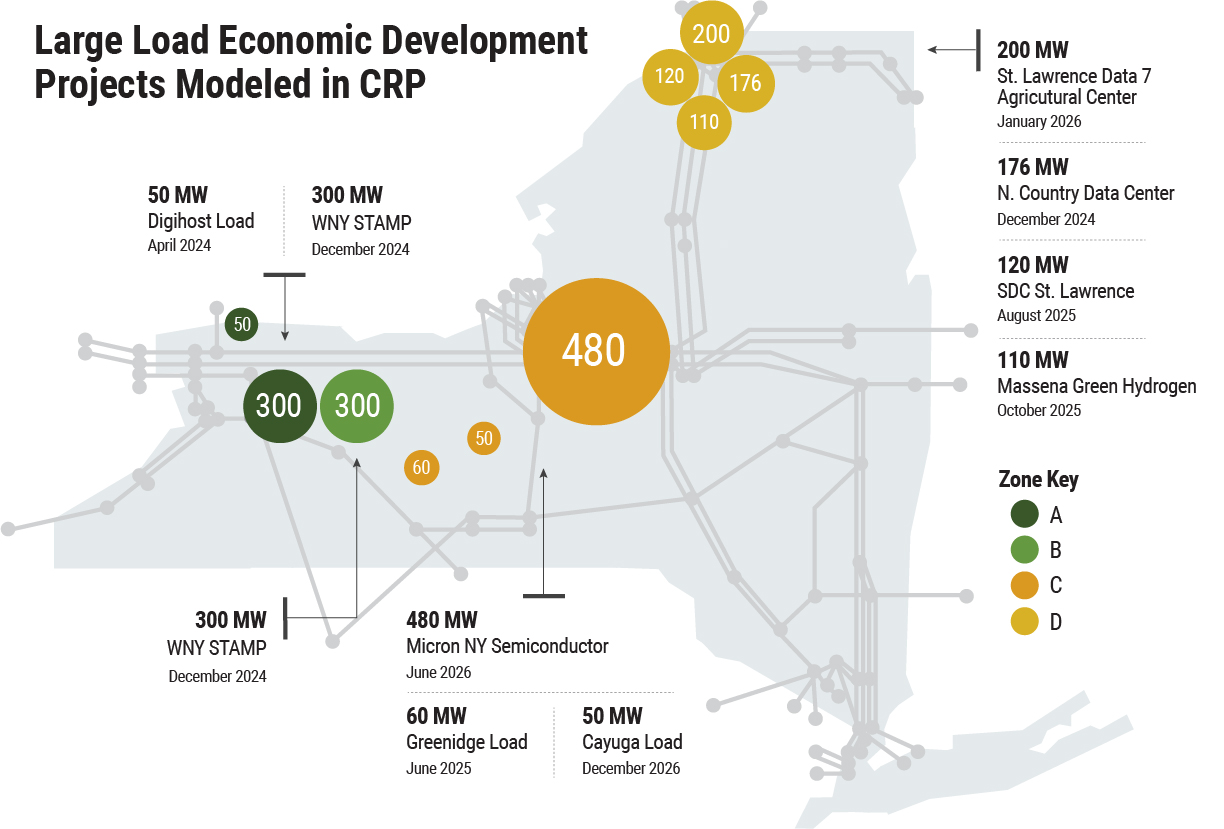Powering Large-Scale Economic Development Projects Requires Proactive Planning and Additional Resources

For the past two decades, demand for electricity in New York grew modestly as energy efficiency programs and new products like LED lighting counterbalanced an increase in demand from smart phones, digital TVs, and computers.
Looking into the future, however, there’s a clear upward trend forecasted in peak demand over the next ten years. In addition to electrifying buildings and transportation, a major driver of the forecast is new industrial load from economic development projects like microchip fabrication and data centers.
The interest by companies looking to site or expand major industrial facilities in New York is welcome news. It proves New York possesses the attributes major employers are looking for when considering major investments for the future. However, one of the main takeaways from the NYISO’s recent the 2023-2032 Comprehensive Reliability Plan (CRP), released in November 2023, shows the need for additional generation and transmission in order to reliably serve this expected growth in future demand from commercial interests.

The CRP is prepared by our System Planning team and provides an in-depth analysis of changing conditions on the electric system over a ten-year time horizon. A major theme highlighted in the CRP is how the advance of new technology and economic development is compounding the complexity of maintaining reliability as we transition to a decarbonized electric system.
The reliability of the electric system is essential for a vibrant economy. And the combination of near-term growth in demand from data centers, semiconductor fabrication, crypto mining, and new manufacturing facilities highlights the challenges for grid planning over the next several years.
Put simply, we need to act now to be able to power these new facilities in the future. This is more challenging than it might seem, and the CRP points out many of the reasons why.
We need to keep in mind that battling the detrimental effects of climate change is an imperative of New York State’s policy goals, which mandate decarbonization of the electric system and certain levels of investments in wind, solar, and battery storage. The NYISO’s mission is to maintain reliability of the grid as we transition to the use of intermittent technologies.
However, our CRP shows that the early stages of the transition are resulting in the retirement of fossil fuel generation faster than renewable resources are entering service. This trend has led to concerns over declining reliability margins – an important element for grid reliability which we’ve discussed and explained in previous blogs. Demand from new large industrial load will also add to resource adequacy concerns.
The CRP also points out the need for additional transmission infrastructure to move renewable electricity from where we expect it will be sited to where it will be needed. It’s not enough to build more generation to meet growing demand – we also need to move that electricity readily around the state as consumer demand dictates. While the CRP points out that electrifying homes, buildings, and the transportation sector will be challenging enough, adding large, new industrial load from large facilities will require investments in major transmission infrastructure to keep the grid safe and reliable.
Additionally, the CRP identifies that the increased frequency of extreme weather events poses risks to reliability. We’ve seen instances across the country where extreme cold has strained grids and resulted in outages with devastating impacts on health and safety. Winter Storm Elliott, for instance, gave us a glimpse into what future challenges may lie ahead in balancing demand with supply when the temperature drops, liquid fuels for power generation are strained, and consumers depend on electricity-based resources to heat their homes and power their vehicles. Adding data centers, microchip fabrication facilities, and other energy-intense operations presents significant, additional challenges for our future grid in extreme weather situations, especially as we contemplate the coming transition to a winter-peaking system.
 Currently, we are a summer-peaking electric system. In simple terms, investments have been made to meet consumer demand primarily for air conditioning during prolonged heat waves. New York recorded a record peak of 33,956 megawatts (MW) in July 2013. Our current total generating capacity to meet that level of demand sits at around 37,500 MW. As our CRP forecasts, the grid is expected to become a winter-peaking system in the mid-2030s as load grows by approximately 1,000 MW a year to accommodate electrification, topping off at around an estimated 45,000 MW in 2036.
Currently, we are a summer-peaking electric system. In simple terms, investments have been made to meet consumer demand primarily for air conditioning during prolonged heat waves. New York recorded a record peak of 33,956 megawatts (MW) in July 2013. Our current total generating capacity to meet that level of demand sits at around 37,500 MW. As our CRP forecasts, the grid is expected to become a winter-peaking system in the mid-2030s as load grows by approximately 1,000 MW a year to accommodate electrification, topping off at around an estimated 45,000 MW in 2036.
As the pace and scale of the state’s energy transition accelerates, the collective efforts of all stakeholders must adapt. A careful and collaborative approach is important as we strive to meet the goals of the CLCPA and maintain a reliable grid. And as residents and businesses across New York become more dependent on electricity to power their lives and livelihoods, the expectation for reliable electricity will also continue to grow.
